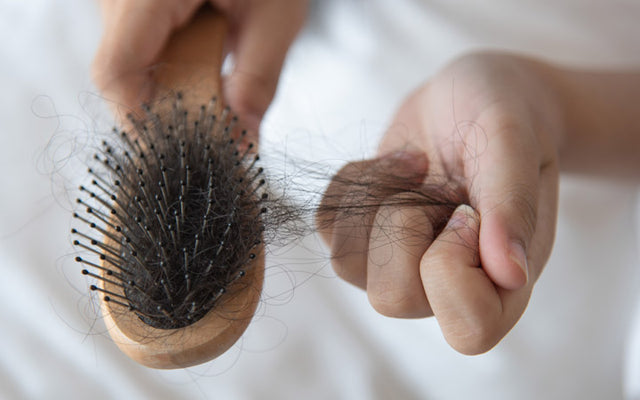Between the blow-dry addiction, straightening habits, hot showers, and regular root touch-ups - sometimes, we're all guilty of being less than kind to our hair.
If your journey down the road to healthy hair comprises one too many products, and more tips than you can remember, you're not alone. Sometimes, all you need are simple and effective hair care solutions straight from the experts.
Read on to find out how you can overcome some of the most common hair problems to help you achieve beautiful, healthy hair.
Highlights:
Common Hair Problems
1. Dandruff
Dandruff needs no introduction. It's when the skin on the scalp peels off and flakes. While dandruff is often mistaken for poor hygiene, the primary causes are dry scalp, excess sebum and sensitivity to certain products.
White flakes can be both embarrassing and challenging to treat. The best way is to keep your scalp clean with an anti-dandruff shampoo or one that contains zinc sulfur and piroctone olamine.
Apple cider vinegar is a quick fix to help relieve dandruff as it contains anti-inflammatory and anti-microbial properties. Coconut oil and tea tree oil also help treat dandruff owing to their anti-inflammatory properties.
Other proven ways to reduce dandruff's severity include reducing stress, consuming probiotics, and adding omega-3 fatty acids in your diet. To avoid a reaction, always test products before you use them and consult your dermatologist.
2. Hair Loss

Losing 50 to 100 strands of hair in a day is normal. If you experience a sudden and noticeable increase in your daily hair loss, it's time to look back at the past three to six months of your life.
Hair loss occurs due to several factors such as stress, hormonal imbalance, and using the wrong products. Once you find the cause of your hair loss, it gets easier for you to address the problem in the right manner.
Some ways you can prevent hair loss include adding protein-rich foods to your diet, switching to a mild shampoo, massaging your scalp with hot oils, staying hydrated, and exercising regularly. Steering clear from heat styling tools also helps. Lastly, if your hair is wet or sweaty, avoid tying it.
3. Dry Hair
If your hair feels rough, it is begging you for protein. Fatty acids like vitamin B5, omega 3 and 6 can help replenish parched hair.
Sometimes, other underlying issues such as menopause, birth control pills, pregnancy, or hormonal imbalance can reflect in your hair texture. Anemia and hyperthyroidism can also cause dryness.
You should treat dry hair with the utmost care and gentleness. Try to ease up on things that make your hair more fragile like sun and chlorine exposure, pollution, chemical treatments, and heat styling.
Hair masks and oils can reverse the damage, soften your strands, restore hydration, and make your hair shiny and manageable. Cold showers and changing the way you dry your hair can also help prevent dryness. If you want to take omega-3 and vitamin supplements, consult with your doctor.
4. Oily Scalp
Of the many reasons like poor diet, genetics, or hormonal changes, the biggest culprit of an oily scalp is overwashing.
It’s a classic example of ‘the egg or the chicken’ syndrome. Are you washing your hair a lot because of your oily scalp, or is your scalp oily because you wash your hair too much?
When you wash your hair more than two to three times a week, it dries out your scalp, and to compensate, the scalp produces more oil. Ingredients like lactic acid help regulate the production of oil.
SkinKraft Tip
Try using lukewarm or cold water to wash your hair. Hot water stimulates the sebaceous glands, which leads to an increase in oil.
Bid Farewell To Oily Hair With These Tips
- Always keep in mind that you need to shampoo properly, condition carefully and rinse thoroughly.
- Avoid hot tools as they make your hair look greasy faster.
- Clean your brush every day to avoid unnecessary build-up.
- Stop playing with your hair - brushing or touching your hair stimulates the oil glands.
- Skip leave-in conditioners and other products that add moisture to your hair.
Note
The amount of oil your hair produces changes with time and reduces as you grow older. Your overly greasy hair will not haunt you forever!
5. Split Ends

When oil from the scalp doesn't reach the ends of the hair, they tend to dry and split over time. Split ends are a cue for a haircut. Even if you're growing out your hair, you need to get regular trims to keep it healthy.
Not trimming your hair makes the splits inch their way up the hair shaft. Eventually, you will need to cut more hair to eliminate the damage.
Heat makes split ends worse, so steer clear, but if you insist, then invest in a quality heat protectant and avoid heat on the ends.
Rubbing a dash of oil onto your ends can minimize the split ends' appearance while also providing nourishment. Avoid over-brushing and shampooing as they can intensify split ends.
Pro Tip
As the ends are drier, it's best to apply shampoo only near the scalp and conditioner from mid-hair to the ends for added moisture. Also, a trim every ten weeks will keep split ends at bay.
6. Frizz And Flyaways
Frizz isn’t just a battle you have to face with humidity. It can strike anywhere, anytime. Even a minor change in keratin or moisture level sometimes leads to unmanageable and frizzy hair.
Over exposing your hair to styling irons, UV rays, chemicals, and color can also cause your hair to poof with frizz. Did you know frizz is usually telling you your hair is damaged?
The key is to add moisture back into your hair with the help of hair masks, serums, or leave-in conditioners. Hot oil treatments also work well to nourish damaged hair.
SkinKraft Tip
If you blow-dry your hair, point the nozzle down the hair shaft to make your hair shiny and frizz-free. Always remember to apply a heat protecting spray.
Here Are Some Other Ways You Can Get Rid Of Frizz:
- Avoid over-shampooing
- Reduce heat exposure - both from water and styling tools
- Protect your hair from humidity with a cap or scarf
7. Dull Hair
It's tempting to turn up the heat of your straightener to 450 degrees to get perfect, sleek hair. But unless your hair is very thick or coarse, that temperature can burn your hair's cuticle and cause breakage.
Many factors can damage your cuticle - from everyday styling to weather conditions, chemical treatments to over brushing, and chlorine to many silicone-based products - the list goes on.
If you want to keep your hair looking fresh and fabulous, it needs protein. Hair is made up of protein, so that's what it precisely needs for repair.
Pick customized products like the ones available at SkinKraft. They are protein-packed and designed to suit your exact needs.
8. Heat Damaged Hair

While it has become immensely popular to embrace your natural texture, something is tempting about using your beloved heat styling tools to crimp, wave, curl, or straighten your hair.
But did you know that it's not just daily use of these tools that can damage your hair? Even the occasional swipe can harm it.
While there is no black and white cure for heat damage, the only real way to eliminate damage is to cut heat out entirely. You can also add hair masks and deep-conditioning treatments to your hair care routine to get adequate moisture and nourishment.
If you're going to use your styling tools, always ensure you use a heat protectant spray beforehand.
9. Hair Color Damage
You know that regular coloring sessions can damage your hair in the long run, yet you may still want to head to the salon when you scroll through endless inspiration on your Instagram feed.
Whether it's a root touch up, bleaching, or highlights, coloring your hair can make it brittle. The chemicals in the dye can also cause dryness, dullness, breakage, and split ends.
If you've colored your hair, you need to give it extra care and attention. Please switch to a specially formulated shampoo for color-treated hair, wash your hair less often, never skip on conditioner, cut down on heat, and pamper your hair with masks.
The above methods can significantly help your color-treated hair recover, especially during the initial days.
10. Hair Loss Due To Health Reasons
Hereditary hair loss, genetics, hormonal imbalances, and menopause can cause hair to fall out. If you experience hair loss that's unusual for you, including clumps of hair falling out, bald spots, and patchiness - you should consult with your doctor or dermatologist.
Wrapping Up
Whether you’re shampooing your hair too frequently or spending too much time with your flat iron, your hair has a unique way of telling you when something is not right, listen to it. Always be cautious and consult a doctor if you need further assistance.
Recommended Products
Was this Article helpful?
- Least helpful
- Most helpful





